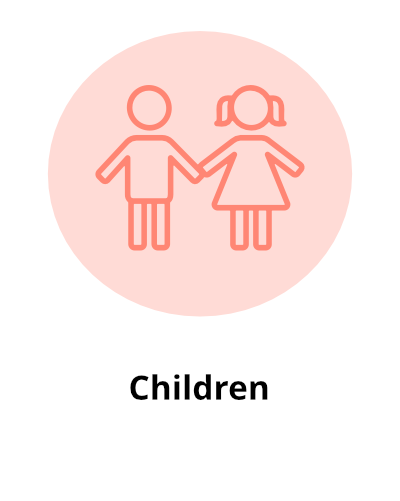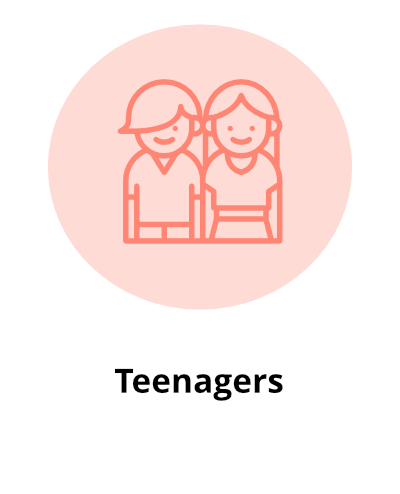Overactive/Impulsive Cluster
Home > TAND Clusters > Overactive/Impulsive > What to do > Children
Children
ADHD diagnosis requires a specialist assessment by a health professional. A formal ADHD assessment may not always be possible, and in some cases, your child may not receive an ADHD diagnosis. It is important to note, that even in the absence of a formal ADHD diagnosis, impulsivity and overactivity are very common TAND behaviours that require support and intervention.
Children who are overactive or impulsive may struggle with emotion regulation (e.g. managing frustration or agitation, staying calm, dealing with anger or upset). It is important to recognise and acknowledge these emotions in your child and support them in regulating their emotions. Observe changes in your child’s facial expressions, gestures and body language, and keep a note of their emotions in different settings (e.g. what do they do when they are anxious, scared or frustrated?).
Remember also to take time for yourself. Managing these behaviours are difficult as a parent. Tips outlined here should be implemented with the support of others, both at home and at school, at a time that works for you and your family. Seek support and prioritise the areas of most importance – manage things at your own pace, one day at a time. See the resource panel for further tips.
Scholastic cluster: What to Do
[tandtoolkit.org]
Neuropsychological Cluster: What to Do
[tandtoolkit.org]
Tips for caregivers of children with TSC
- Keep instructions simple and brief.
- Establish clear rules and boundaries in the family home.
- Establish visual schedules and routines. Offer prompts to keep the routines on track. Use reward charts for motivation.
- Be predictable and consistent.
- Avoid unnecessary distractions and implement a structured approach.
- Helpful tips especially for parents can be found in the resource panel.
Parenting a Child with ADHD
[chadd.org]
ADHD Parenting
[additudemag.com]
Reward Charts
[docformats.com]
Plan the day
- Establish visual schedules and routines. Use picture cards and visual timelines to make routines clear and easy to understand. Use additional cues and gestures if necessary to aid understanding. For example, a bath picture card can be used to indicate bath time, but a rubber duck may also help to establish this association.
- Be predictable and consistent when establishing a routine. Avoid unnecessary distractions and implement a structured approach. Allocate time in your day to work through the visual schedule with your child. Make it fun, and offer choices when planning their day. For example, it can be part of your evening routine to lay out the cards for tomorrow’s morning routine (e.g. which breakfast cereal to have, or which t-shirt to wear).
- Establish a consistent bedtime and mealtime routine. Establish healthy eating habits, and reduce access to caffeine and refined sugars. Endorse relaxing sleep hygiene strategies, minimise use of electronic devices before bed, incorporate daily exercise and screen breaks into your child’s routine.
- Use visual reminders and offer prompts to keep your child’s routine on track. Visual calendars and timetables used by all the family will help your child feel supported and involved. Decorate the timetable together, have it visible in the family home, and work towards rewards when goals are achieved or tasks are completed. Use reward charts and establish a schedule of rewards to help keep your child motivated.
- Necessary sit-down activities can be ‘chunked’ into more manageable periods. When your child is expected to stay seated for an extended period of time (e.g. during meal times, in the classroom), be realistic in your expectations. As a rule of thumb, double their chronological age as an indication of how long they can remain seated (e.g. 7 years old = 14 minutes). Allow small breaks away from the table, minimise other distractions (e.g. no television during homework time) and practice these ‘sit-down tasks’ regularly within their daily routine.
- Introduce your child to the concept of ‘waiting demands’ regularly in their day, and practice coping strategies and techniques. Waiting is incredibly difficult for any child, and especially difficult for children who are impulsive. For example, wait 5 minutes after they have finished their meal before getting dessert. Use visual aids to support their waiting (e.g. set a visual timer for 5 minutes, use a ‘wait’ card, offer lots of praise and social engagement).
- Identify and prepare for situations where waiting demands may be prolonged and unavoidable (e.g. waiting at a restaurant, being stuck in traffic, waiting in queues). Have interactive activities, songs and games on hand to manage these unavoidable situations. Carry a bag of small sensory toys, cards, books, crayons and paper with you for these situations.
Giving instructions
- Keep instructions simple and brief. Leave out unnecessary details and provide only one instruction at a time. ‘Make your bed’ is easier to understand than ‘You need to make your bed before you can come downstairs because your room is a mess’.
- Establish clear rules and boundaries in the family home (e.g. no jumping on furniture, no television during mealtimes, clean away toys after play). Have these displayed visually and remind your child of these rules regularly. Offer clear instructions to support and re-direct their behaviour and be consistent in your response when rules are broken.
- Provide your child with a ‘safe space’ at home or school, a quiet corner/room/den they can take themselves to when they are feeling upset or overwhelmed.
- Use visual cues and aids to help with time management. Large egg timers, study timers, countdown clocks, buzzers, and alarms can all be used to set realistic goals for task completion and signalling when a break is due. For example, set a 2 minute timer for teeth brushing, a 10 minute countdown for cleaning away toys.
- Reward small wins. Start by focusing on the task that is of highest priority to your child and family (e.g. teeth brushing in the morning, eating a family meal together, completing homework on time). Practice this skill together consistently every day, be realistic when goal-setting, minimise distractions, support your child with visual cues, calendars, timetables and checklists, and offer praise and rewards when a new skill is mastered.







